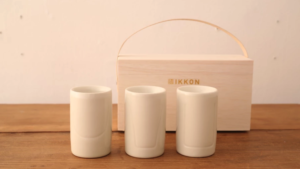IKKON STYLE
Master liquorYuki Aoi
2018.04.22
How to enjoy IKKON,
2nd liquor master Yuki Aoi
Yuki Aoi, a freelance announcer and Japanese sake coordinator who is active on television and radio, introduces how to enjoy Japanese sake at IKKON.

―The three types of IKKON only have the same appearance but different shapes. In other words, the structure is double-baked, but what about this feature?
Double-baking is a feature of Ohori Soma Yaki. I think that it is very good that the temperature is kept whether it is cold or warm. It would be nice to enjoy how the taste changes depending on the temperature, whether it is hot or hot. Since the hands do not touch the inner layer directly, it is safe to make it quite hot (laughs).
By the way, “cold” originally means room temperature. In the era when there was no refrigerator, we couldn’t cool it above room temperature. Nowadays, it is often confused with “cold sake” chilled in the refrigerator.
―That’s right. This double baking was originally created for cold and warm insulation. However, IKKON was the first to challenge double-baking for the purpose of changing the taste of liquor depending on the inner shape.
I think this is a very interesting challenge. I don’t think there is usually much sake drinking in this size vessel. Since ordinary chopsticks are much shorter and there are few stones, when I first looked at IKKON, I felt that it was a bit sloppy. However, when I actually drank it, I thought it was very interesting to see various faces of liquor depending on the inner shape. If possible, I would like you to compare three different drinks side by side. Can Japanese sake lovers get together and do something like a sake game? IKKON is only easy to carry because there are 3 types in the box. I think it’s great to enjoy not only the type of liquor, but also the difference in taste depending on the vessel.
profile
–
Yuki Aoi/Japanese coordinator
I am qualified as a master liquor and shochu advisor and am struggling every day to convey the charm and importance of Japanese food culture. Named “Sake Samurai” by the Japan Sake Brewery Association.





